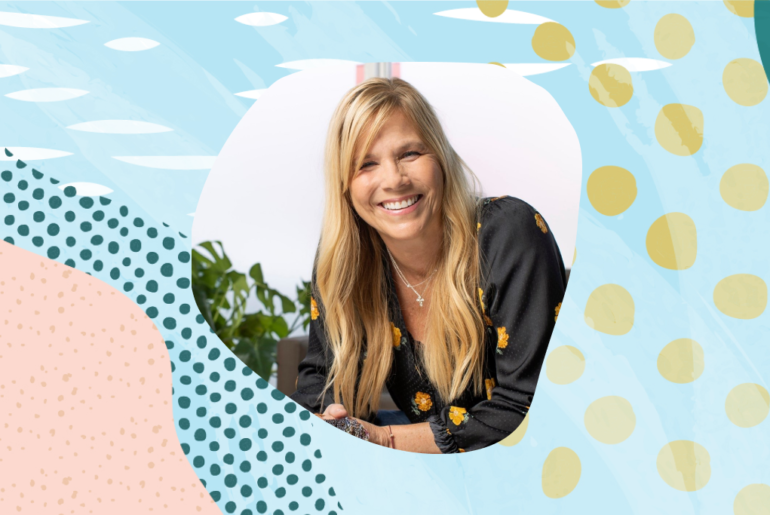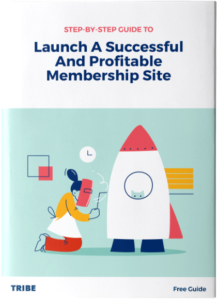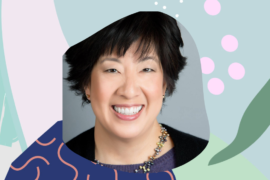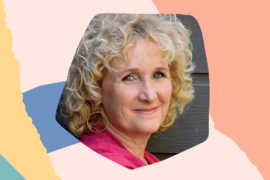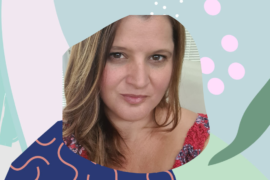Lifelong knitter Shelley Brander worked her way up in the advertising industry and had great success, but knew she didn’t want to sell cable TV and casinos for the rest of her life. She opened a modern yarn store with the intention to franchise, but after seven years still hadn’t taken a dollar of profit.
Now, at Knit Stars, Shelley has up-leveled her industry. She provides over 12,000 people with a platform to build businesses, discuss difficult topics, and get paid what their creativity is truly worth. She’s also the author of Move the Needle: Yarns from an Unlikely Entrepreneur, which will be published by Hay House on January 12, 2021.
Today, Shelley joins the podcast to talk about the legacies we build in life, the value of empowering her fellow artists, and the big wins she (and her clients) have experienced along the way.
Key Takeaways
- How Shelley learned to write a business plan in exchange for sushi.
- Why a successful online product launch solved Shelley’s seasonality problems.
- Ways Shelley’s membership has transformed her clients’ lives.
- How membership businesses give a voice to what may seem only to exist in silence or in silos.
Free Give
FREE Guide – Launch & Grow a Profitable Membership Site
Ready to reclaim your time and attract more monthly paying customers? Our step-by-step guide will show you how to build a membership site that turns your passion into recurring profit. Click here to download!
Memorable Quote
- “Yarn really is a metaphor for life, because people, like stitches, they’re all connected.” – Shelley Brander
Episode Resources
- Move the Needle: Yarns from an Unlikely Entrepreneur by Shelley Brander
- Knit Stars
- Bird by Bird by Anne Lamott
- LoopsClub
- Shark Tank
- Modern Calligraphy Summit
- needlebook.com/bundles
Transcript
Read The Transcript
[INTERVIEW]
Shelli Varela: Shelley Brander, welcome to the It’s a TRIBE Thing podcast. I am so excited because unbeknownst to you, you happen to be one of my favorite people.
Shelley Brander: Well, let’s meet you all, Shelli, and we know we have a name in common. So, all the best people are Shelleys, right?
Shelli Varela: Well, I like to thank you. You and your story have inspired me. I had the great privilege to spend some time with you, maybe nine months ago, and your story is incredible. The way you make people feel about their story and their possibility through your examples is humbling. And so, thank you for being who you are and doing what you do. And if we may start with, who do you serve and what do you do?
Shelley Brander: Yeah, so I serve people that love yarn, knitters and crocheters, those are my people. And in a broader sense, creative people of all kinds, makers. So, yeah, that’s my audience. Boy, you’re a little surprise.
Shelli Varela: Well, I know. Well, I remember when I first met you, we were chatting and I knew that you have this incredible business and you’re very dynamic and you’re creative and you’ve got all of these things going on, but your business is yarn. And I remember thinking like, how is that thing and you have a book now coming out called Move the Needle: Yarns from an Unlikely Entrepreneur, can you tell us the beginning of your story and what led you to being a published author?
Shelley Brander: Yeah, so I had just finished. It was a few years ago that the idea came into my head. I just finished filming for Knit Stars, which is our annual online digital festival that we have for knitters and crocheters. And I was flying back from Norway, Finland, and Denmark, where I just had the most life-changing experience, filming some famous knitting people. And I was exhausted and I pulled up the audible on my phone. And the first suggestion was Bird by Bird by Anne Lamott and if you haven’t read it, you should.
Shelli Varela: My favorite author, as we were saying, like, just incredible, especially Bird by Bird.
Shelley Brander: Yes, totally. And she has a great TED talk if people want to get a little sampling. And something started to just stir inside of me to write a book and to share the story. And I get the question very often from people how in the world did you do this with yarn. And I can see the transformation that happens in people’s faces when they see that if Shelley can do this with yarn, I can do it with whatever my own weird little niches. And so, I thought, what better way than a book to get the word out in a mass way and in an enduring way, so that I can inspire other creatives and makers to make their hobby, their jobby.
Shelli Varela: Their hobby, their jobby, I love it. So, just for clarity for the listeners, when you say, do this with yarn, can you give everybody a backstory about the incredible creative ventures that you’ve had with yarn? Like it would be to say you’re a knitter, but you’re actually not, you’re kind of like the knit guru in many ways and has been in this incredible business from something that’s seemingly atypical for sure.
Shelley Brander: For sure, yeah. So, I started out not in yarn, but in advertising. I was a copywriter, I knew I wanted to be a copywriter. I worked my way up in a very male-dominated world to being a creative director. And I met my husband who’s an art director at an ad agency, and we got married and we formed our own agency. And it was really, really successful.
We had clients like Hard Rock and Cox Communications and AT&T, but something started to stir within me to do something different. I just was like, do I really want to sell cable and casinos for the rest of my life? Do I want to pass that down to my children? And I had learned to knit when I was 16 years old and I was like the only knitter I knew for years and years and years. There was no community and I would go into yarn stores and they would wonder what this kid was doing in there.
And I can never find anything really cute that I wanted to make, everything was very old fashioned. The yarns were scratchy, itchy, yuck. And often, I would go into stores and leave after hours, just disappointed, not having had a good customer experience, not having done anything I would actually make. And so, the one shop that I would go into on a regular basis, she said she was going to retire and suggested that I start a yarn store and I very nicely said she was crazy because at the time, I had this booming branding business and I had three kids under 5 and I couldn’t imagine, but it stuck with me.
And I think a lot of people have this experience, where there’s something that just for some reason keeps bubbling up and up and up. And even though it might seem so insane, something keeps nagging at you, like this is the direction that I meant to go. And the universe, whatever you want to call it, it kept whispering in my ear. And so, I didn’t know how to write a business plan, so I got a friend who had an MBA and I bought him some sushi. That was the first time I had edamame by the way, and I was so nervous and I didn’t know how to eat it. So, I totally ate the whole pea.
Shelli Varela: I will very, very easily shell like a business plan for some sushi, like that’s a pretty fair trade, I’d say.
Shelley Brander: It is really good sushi. So, now, his name is Scott and he’s a great guy and he helped me write the lease proposal and I decided I wanted my store to be and of course, like the coolest shopping center in town. And it was owned by a billionaire oil baron and it was his little side thing that he had this cool shopping center. And actually, as it happened, Scott worked in the petroleum industry. So, he knew a little bit about the oil baron as well.
And so, I submitted my proposal, I was so proud of it. And I got crickets, no response. And then, I would call and they’d be like, Well, yeah, he likes your proposal, but I don’t know that it’s really going to be a fit, we don’t have a space. And I would drive by and I would see they had space. And so, I kept calling every month, every month, every month for two years. And I finally said, “You know what? I’m going to give it one last try.”
I ordered some cashmere yarn from New York, I made him the cable scarf. I wrapped it up really cute, put a nice little letter with it about why the store needed to happen in his shopping center. I dropped it off. I found out where he lived. I stopped him just a little bit. And I dropped off the package on Christmas Eve. And then, the day after New Year’s, I got the lease deal. So, it was like, Oh, crap. Now we got to make a store. I don’t know what I’m doing.
Shelli Varela: You never saw it coming.
Shelley Brander: Right. Like, Oh, wait, I know, I actually have to do it. So, I did the thing. I wish I hadn’t done that line, at the time, done is better than perfect. Anyway, I did open the store, I have the store for about seven years. And my goal was to franchise. I hadn’t done any independent franchise in the yarn business and that was my goal. And my store was, from the beginning, the idea was a very modern yarn store, very easy to navigate, the opposite of what I’d seen everywhere else, but we opened a second store, we had a lot of things go wrong.
Our inventory couldn’t be combined online. So, like our big plans for online e-commerce growth were thwarted. There were a lot of energy problems that popped up like the two teams of the two stores were fighting. It was like North versus South, who has the good yarn? And it became just a bad vibe and I was about to close the whole dang thing, I came really close to.
To me, it was more embarrassing, it would be worse to shut one of the stores down because that would look like more of a failure than if I just didn’t close the entire thing and said, I’m just going back to branding. And in year seven, I had not yet taken a dollar of profit. So, in year seven, I did it at seven years and I was still doing the branding business. My intention was to be out of branding after a year and I’m still doing branding. And it was a real moment, of like, what am I going to do?
And at the end of the day, I decided, Okay, I’m going to go ahead and close both stores, but I may open a new one in the middle and really work on the online growth. And the day that that happened, things really started. Literally, I woke up, I’d been up till three in the morning cleaning, getting everything ready. And I woke up and I was like, this is the right direction.
And just a few months after that, I ran across Jeff Walker’s Product Launch Formula online. I had never done an online course of any kind, I didn’t even know how it worked, but I also assumed that if you spend money on a course that, of course, you do every bit of it and implement it, doesn’t everybody?
Shelli Varela: Yes. We all do that.
Shelley Brander: Right, exactly. So, I didn’t know any better.
Shelli Varela: You branded that course.
Shelley Brander: I actually did, I have pictures of my wall covered in legal pads and Sharpie. And by about the second module, I came up with the idea for LoopsClub which is our first membership. And it was a luxury yarn kit paired with a really cute pattern and then support and community to help people accomplish the kits.
And that first launch in seven days, it did $75,000. And at the time, there weren’t programs like that out there now, of course, that was in the early days of box memberships. And so, that took off and the big thing that did for us is it solved the seasonality problem, for a yarn business, so seasonal. You hear that on Shark Tank all the time. They hate seasonal businesses.
Shelli Varela: Yes.
Shelley Brander: And I hated the seasonal business because it was like feast and famine and like fall and winter would be awesome. And then, we’re in Oklahoma, we’re not in Canada, so we don’t get the cold quite so much and so, we’d be nail biting all through the spring and summer, can we make our bills? And with a membership, it flattened all that out. We were able to ship kits every month and we had consistent income. So, that was a huge relief.
And then, long story short, I want a case study. Jeff Walker made a case study about me and I went to his live event as part of the prize of winning the case study contest. And at that live event, I was approached by women who had done an online summit in calligraphy called Modern Calligraphy. And she broached the subject of a knitting summit and I laughed at her and said, “No way, I don’t have time. There’s no possible way I can do that.”
But it’s out with me, too, because I was just very intrigued, I thought this is really different, there’s nothing like this. And I love the idea of bringing together my production background and my storytelling background from the ad business and the branding business together with my love of yarn. And I was also really intrigued about up-leveling my industry, because my industry of knitting, there’s perception that it’s crafty, it’s old fashioned, it’s not cool, it’s like grumpy people.
And I wanted to up-level the production quality and the industry, what people were used to seeing, bad YouTube videos. And I wanted to up-level what people are paid because the best and brightest, the Knit Stars that we get that have built these amazing followings pre-COVID that are traveling every single weekend all over the country getting paid literal peanuts to do what they do. And the structure of Knit Stars lets them earn quite a bit more and really gives them what they deserve. And so, that feels like we’ve built community, we’ve up-leveled what they’re paid and what they believe, their creativity is worth.
We’ve connected, there’s more than 12,000 Knit Stars owners around the world. We’ve connected them in this amazing global community. And because we’ve created this incredibly safe, nurturing environment, we’re able to tackle the more difficult topics of our day. We’re able to discuss racism, inclusion, bringing in the representation of all backgrounds of all areas of the world. All, I mean, you name it, our goal is to have full representation with Knit Stars.
Shelli Varela: That’s so beautiful. It’s so funny, like we were chatting earlier and your yarn is the vehicle for, I feel, what you’re actually doing which is possibility and stories and just giving examples of what it can look like to say yes to the right thing. And I want to dive in with that because there’s some things that are I’m sure not lost on the listeners that I just want to pull out a little bit more because they’re such gifts, but bring us back to that full circle moment, you’re on the plane and you’re reading Anne Lamott Bird by Bird.
Shelley Brander: Yeah. And it hit me that I missed writing. And I was like, if I could share the story and inspire, really let people see that their creativity has value and that their impossible dreams really can come true, if the thing that people tell you over and over and over that you cannot do, I mean, if something keeps nagging at you that you need to do it, you need to listen. I mean, everyone thought it was completely insane to start a yarn store.
My sister worked for us at the time and she quit. She’s like, you’re going to take your whole family down. I mean, her thinking, she said, what everybody else was thinking. You’re going to tank your whole business, you’re just giving all this away, all this, and it did seem really insane for a long time, but I can’t imagine now, if I were still doing branding, no, like, what kind of impact would that be having? There’s no way if I hadn’t moved forward through that, all those can’ts, there’s no way that I’d be having an impact right now that I’m having on people, I mean, every day.
You think yarn is not a big thing. Yarn really is a metaphor for life because people, like stitches, they’re all connected. Like if you ever snagged a sweater, what happens to all the other stitches? They’d all get pulled.
Shelli Varela: It’s all one thread.
Shelley Brander: Yeah, it is literally all one thread. And our mission is to knit the world together. Like it’s happening, it happens every day. You see people connect with each other. They’re in airport, getting free COVID there in airports and they see other people with their loop bags and they connect over these things, anyway.
Shelli Varela: It’s kind of like Seth Godin says, people like us do things like this and it is the community. I own a Jeep and it’s very much, Oh, you give the peace sign when you’re driving by because it’s a Jeep thing, but it really is more than that, it’s a belonging and an inclusion. And it’s like people like us do things like this.
Shelley Brander: Yes. And so long, I felt so alone, I felt so isolated as a knitter. I didn’t know anybody else like me who did it, I felt weird. And even as a kid, and I talked about this in the book, I was bullied, I always felt a little different. And to be able to create that connection for people, especially, we’re so everybody says, spread out now. Yeah, there’s people who live in cities that are able to make those connections, but with the world so spread out, so many knitters that I knew were out there with no support system, no community.
And knowing that I’m bringing them all together and then like, helping them develop a better appreciation and understanding for different areas of the world and different knitting traditions and just differences of opinion. Once you create that safety, then people are able to have the more difficult conversations.
Shelli Varela: Yeah, you give a voice to what previously exists in silence and silos.
Shelley Brander: Yes, I love that. That’s so true. And I love Seth Godin, too, by the way. He’s the one email I think I read every single day. I made him a scarf, I sent him a scarf, too. I do that every once in a while, sending a random scarf.
Shelli Varela: Oh, my gosh. I could honestly talk to you forever. There’s just something about you that is so alive and vibrant and I don’t know.
Shelley Brander: Likewise.
Shelli Varela: I want to see healing and actually, like that’s not even an overstatement. And the thing that I love about this book is, it’s going to inspire so many people. The title Move the Needle, just so clever, but it really does speak to that which Shelley Brander is, you’re talking about when you dropped the scarf off at the billionaire’s house and you wrote a note about the story. And that wasn’t lost on me, that you were getting the automatic no before that. And then, once you write this note and once you tell them the why and paint a picture, because I have the saying, it’s audience gets no jobs and you can’t expect them to see what you see, you have to show them what you see. And then, once you did show him what you saw, everything changed for him. And I believe that that’s what this book is going to do.
When you were talking about it you knew it was the right direction, you said when you went online and you started the membership site, you knew it was the right direction. For those people who are sitting on something that feels like, maybe it’s the right direction, but are scared or don’t know what to do, for you, how did you know that that was the right direction?
Shelley Brander: Well, I mean, when you get that first sale, that helps, right? That’s like validation. I knew it was the right direction because it would sell the seasonality. I knew it was the right direction because it was the best way to serve them. Like, I knew that all those people were out there without really good direction with their knitting. They would waste a lot of time going down a lot of rabbit holes, researching projects and not really feeling confident, I just knew that it was a huge pain point that people didn’t have a clear success path for their own knitting journey and by giving them pre-curated kits, first of all, they get the surprise in the mail, everyone loves a surprise. A good day is when Amazon shows up.
Shelli Varela: And it’s not a bill, yey.
Shelley Brander: Exactly, something besides a bill. And you say, get that fun of opening up and then you get something we say on trend and effortless, like we were committed to our kids being simpler rather than what I call show-off knitting. There’s a lot of show-off knitting, like really impressive, but not necessarily something that everybody can easily make and have community around and then actually want to wear, a lot of things are impressive to knit, but you don’t actually want to wear them.
And then, to have the community support and the safety net there of a local yarn store, that’s why a lot of people don’t pick up knitting, they think, I can maybe learn it from that YouTube video, but then what happens if I drop the stitch? How do I know what my next project should be? How do I know how to put colors together? What if I want to learn this technique? What if I get into the pattern, I can’t do it?
And so, just giving people that safety net, I think, was a huge thing in my world. In the knitting world, I realized that that was a big thing that was missing. And even as people started to create more box and bag memberships, like that became a big thing, I don’t really know of any that offer that level of support, like the yarn store support. So, another reason I knew it was the right direction is it let us really spotlight indie dyers, there’s like independent artisans that develop yarns, lots and lots and lots of them. And it let us support those people and indie designers.
And so, we call up and say, “Hey, we need 1000 skeins of yarn.” I mean, that’s a big day for an independent dyer, who’s trying to sell one skein at a time on Etsy. And so, I loved that. I could see the potential really, the whole rising tide lifts all boats thing, like I could really start to see that picture. And then, Knit Stars, same thing. Every year, we have 10 new stars, each of them has a dire that they work with. So, we’re providing a huge platform for those people without them having to create it.
And then, ironically, I’ve been told actually, by our Knit Stars, all of them do really well, but we have a couple guys in Norway, Arne and Carlos, who have huge YouTube following, people around the world, they know these guys. And after we had a really great Knit Stars season with them, it was very lucrative for them, it was great, but he said, “I’m so glad I did this.” The number one reason was actually what you taught me about marketing because before that, they were giving everything for free. It was all for free on YouTube and they were afraid to ask for the sale of any kind, even a pattern, even a $6 pattern.
And after we talked and they saw what was possible and they saw that people were willing to pay $200 for Knit Stars season, they moved everything, I mean, almost all their stuff, to their own, they built out a website, put everything on, totally changed the game for them. And so, I helped them believe in the value of their own creativity. Even somebody at that level, like at the very top of the game inside of an industry was afraid to charge for what they do. And I think that’s true of all creatives. It’s such a struggle to really value what you’ve got.
Shelli Varela: I love everything about who you are. And your curiosity is absolutely infectious and I can only imagine that that lack of fear that you have of like cartwheeling into the unknown, is also the thing that makes people who are following you and joining you in part of your community safe because they’re like, what happens if I drop the stitches, just you have this way about you. And this book is going to be so much more to so many people because it’s about hope and it’s about you don’t have to know and it’s about what is the right direction and what does the right direction feel like in tuning into that and just doing it, like you have made an empire out of yarn, but what you’re about to do with this book is even bigger than that.
Shelley Brander: I want to say Shelli, can I say real quick? I’m cartwheeling into the unknown, but trust me that I am loaded with fear still. I do try to do the one thing every day that I’m afraid of. I was up at the top of a volcano two days ago, terrified of heights, I mean, terrified. And I mean, I was shaking. And my biggest fear with writing the book was that people would believe that I was somehow special or like this unicorn, and then it can’t work for them. But when you read the book, you see that it’s exactly the opposite of that. I want people to read the book and believe in themselves.
Shelli Varela: Well, the thing that I love about the book is, it’s before people care to understand you, they have to first feel understood. And you do such a great job at sharing your story in a way that people say, Oh, I’m not just like you, I am you in some ways. And if you went on to do that, then what might I be able to do that is my version of that? Thank you so much for coming out and hanging with us on the It’s a TRIBE Thing podcast. If people are looking to get your book, Move the Needle, where’s the place they can find you online?
Shelley Brander: So, I recommend that you go to the needlebook.com/bundles, B-U-N-D-L-E-S. We have a couple of great pre-order bundle bonuses right now. And people can choose the maker package or the entrepreneur package and you can gift it to people. We have gift bundles with a printable. So, if you know somebody who’s an aspiring entrepreneur or you maybe have a group like an accountability group, you could gift it and give them a printable. And that’s available until the book publishes on January 12.
So, if you want to get in before and get the deal, get the bundle, get the bonuses, that’s the best place to go. It’s also available, you can buy the book anywhere, you can pre-order right now on Amazon and you can take any of the different places that’s shown on that page. There’s a number of all the major retailers. So, this is a hot tip, if you’re in Canada, you need to make sure that your address that you’re ordering from, like your billing and shipping address, that you’re on the Canada Amazon and that you put Canadian addresses in there or they can look like it’s not available, but it is, pre-order is definitely available.
Shelli Varela: Yes, buddy, I so appreciate you, always makes my heart happy to chat with you. And I know this book is going to change so many people’s lives and give them hope, where none previously existed, especially during COVID time. So, thank you for being you and thank you for showing up.
Shelley Brander: Thank you. I hope so.
[END]
To learn more and get access to all episodes, visit our podcast page!
